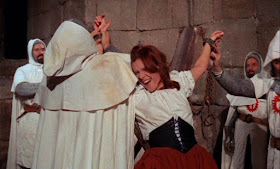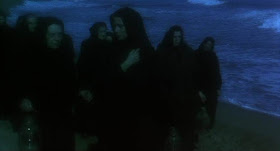“Do you remember the voodoo rites? Faust, and all those who
make pacts with the evil spirit do so with blood. The knights performed human
sacrifices, consummating the offering with a virgin’s blood. Now they’ve
awakened from the beyond, and without eyes to see, they find their victims by
the sounds they make, and continue to offer human sacrifices to their evil
master.” – Professor Candal (Francisco Sanz) (from Tombs of the Blind Dead)
With the advent of the Blind
Dead films, Spanish filmmaker Amando de Ossorio introduced a new form of
zombie, an eyeless, ambulatory half-ghost/half-living dead being. Over the
course of the four installments, the re-animated corpses underwent several
permutations, but followed a common thread. In one way or another, Templar knights
make a pact with the forces of evil, and as a stipulation of their unearthly
contract, must feed off the blood of virgins to stay alive.
Of course, all of this undead mayhem requires a certain
suspension of disbelief. As the slow-moving corpses inexorably make their way
toward their screaming victims, we all know their prey have ample time to
escape, but that’s not really the point of these movies. The knights represent
the inevitability of fate and grappling with forces beyond our control. Why are
their victims so passive? I’m not an historian or global politics buff, so I
might be going out on a limb when I propose this series of films was de Ossorio’s
veiled response to Franco’s fascist regime. The Templar knights seem to
represent the stranglehold the pre-1975 Spanish government held over its
citizens. Living in constant fear of reprisal, the citizens resorted to learned
helplessness as a dysfunctional coping mechanism. The few malcontents who
attempt to battle the knights usually meet terrible ends, so not fighting them
seems the only sane response.
Tombs of the Blind Dead (aka: La Noche del Terror Ciego) (1971) Directed by Amando de Ossorio;
Written by Amando de Ossorio and Jesús Navarro Carrión; Starring: César Burner,
Lone Fleming, María Elena Arpón, José Thelman and Francisco Sanz
Available on DVD
Rating: ***½
In de Ossorio’s first film, two old friends, Bette and
Virginia (Lone Fleming and María Elena Arpón) meet at a resort in Portugal, and
decide to embark on a camping trip. When Bette’s boyfriend Roger (César Burner)
enters the mix, it stirs up long dormant memories in Virginia (the European cut
includes a flashback scene where Bette and Virginia experience a brief lesbian tryst
during their college days). They take a train together, but Virginia unwisely
decides to disembark midway before their destination. She ends up in an old,
abandoned village that was once the domain of the ancient Templars, and meets
her untimely demise.
The rest of the film shifts the focus to Bette and Roger, as
they attempt to uncover the mystery of the strange village and Virginia’s
death. We learn about the 14th century Templar knights, who returned
from Egypt with the secrets of eternal life. Their sadistic rituals became
legend, and kept the surrounding locales gripped in fear through the present
day. Centuries after they were destroyed, the knights rise from their crypts to
exact revenge against the living.
Compared to the
later entries in the series, Tombs of the Blind Dead is the most artful of
the bunch, containing some fancy shots and inventive murders. Borrowing from
the Italian thrillers of the period, the film has a distinctive giallo vibe. In
one memorable scene, an employee in Bette’s mannequin shop is stalked by
Virginia’s reanimated corpse (the shop is conveniently located next to a
morgue), with the room bathed in flashes of red light from a neon sign. You can
run from the Templars, but escape from their wrath is futile. As the haunting
final scene asserts, death is the only option when you cross their path.
* Fun fact: In a lame effort to cash in on the success of
the Planet of the Apes movies, Tombs of the Blind Dead was marketed in the U.S.
as Revenge from Planet Ape, despite
the film’s conspicuous absence of ape-men.
The Return of the Evil Dead (aka: El Ataque de los Muertos Sin Ojos) (1973) Written
and directed by Amando de Ossorio; Starring: Tony Kendall, Fernando Sancho,
Esperanza Roy and Frank Braña; Available on DVD
Rating: ***½
This worthy follow-up to Tombs
of the Blind Dead more or less picks up where the last one left off, but throws
the Templar knights’ origins out the window (in the original film, the Templars
were hanged, and crows ate their eyes out, but in the second entry, the knights
are burned). The film is set in the small Portuguese town of Bouzano, where an
annual celebration is held to commemorate the citizens’ victory over the
knights centuries ago. But wouldn’t ‘ya know it? The legend about the knights
rising from their graves to wreak havoc turns out to be true.
The Return of the Evil
Dead aims for action over art. Once again, the knights are easy to escape,
but the passive townspeople quickly succumb to them. For some unexplained
reason, the knights’ numbers seem to have multiplied, compared to the first
film. What once started as a small group of murderous demon knights now appears
to be a few dozen. The survivors huddle
together in a monastery, in a vain attempt to barricade themselves from the
undead hordes. Similar to Night of the
Living Dead, this confinement brings out the worst in a select few, notably
the loathsome mayor Duncan (Fernando Sancho). In his effort to escape the
clutches of the knights, he uses one of his willing civil servants, along with
a young girl, as pawns. Things don’t go well for Duncan.
The Ghost Galleon (aka: El Buque Maldito) (1974) Written and directed by Amando de Ossorio;
Starring: Maria Perschy, Jack Taylor, Bárbara Rey, Carlos Lemos and Blanca
Estrada; Available on DVD
Rating: **½
The Ghost Galleon
(which also went by the more generic title, Horror
of the Zombies) is easily the weakest of the four Blind Dead films, thanks to a feeble story and sloth-like pacing. It’s
notable only for the novel setting, and an endless parade of polyester fashion
atrocities. As part of a millionaire’s (Jack Taylor) ill-advised publicity
stunt, two fashion models are stranded on the open ocean, and encounter a
(presumably) deserted 16th century sailing vessel, shrouded in fog.*
As it turns out, the ship’s captain was a devotee of the Templar knights, and
transported their bodies across the ocean (to where, it’s never made clear).
* I couldn’t help but speculate if this movie provided some
inspiration for John Carpenter’s superior take on similar subject matter, The Fog.
Compared to its two predecessors, most of the film is
painfully dull. I understand the need for dramatic tension, but that shouldn’t
constitute the bulk of the picture. It takes almost half of its 90-minute
running time for something to occur. When it happens, it’s a welcome respite,
but we’re not invested enough in any of the characters to care. The final scene
is suitably unsettling, but it doesn’t excuse the glacial scenes that preceded
it. What should have been a tense, claustrophobic excursion into horror turns
out to be an uninspired, pointless exercise in tedium.
The Night of the Seagulls (aka: La Noche de las Gaviotas) (1975) Written and directed by Amando de
Ossorio; Starring: Víctor Petit, María Kosty, Sandra Mozarowsky, José Antonio
Calvo and Julia Saly; Available on DVD
Rating: ***
The fourth and final entry in the Blind Dead series is an
improvement over the previous film, although by this time the concept is
wearing a little thin. Unlike the former film, The Night of the Seagulls jumps right into the action, albeit on a
familiar note (ho-hum, another sacrificial altar scene). Once again, instead of
maintaining continuity between each of his Blind
Dead installments, de Ossorio casts a slightly different spin on the mythos
of the Templar knights. This film asserts the knights originated from France
600 years ago. In a nod to Lovecraft, they worship an undersea god (who
resembles a frog).
A doctor and his wife (Víctor Petit and María Kosty) move to
an isolated seaside village populated by suspicious, unfriendly people. They
observe a procession of cloaked figures on the beach, which turns out to be
part of a seven-day ritual to appease the undead knights. The village’s silence
and strict adherence to a barbaric tradition serves as a warning against complacency
and blind acquiescence to the group.
The sexist, thick-headed doctor is the film’s weakest link. Instead
of choosing to believe her suspicions about the townspeople, he chooses to
chalk off his wife’s concerns to hysteria. As a result, it takes forever for
him to arrive at the realization that something’s amiss, and plan an escape. While
it occasionally stumbles, Night of the
Seagulls is a fitting final entry in the series, concluding on a hopeful
note. The closing scene reminds us it’s possible to break a chain, but it requires
a new approach to an old problem.














These films are completely unknown to me. Thank you for introducing them through your reviews, Barry!
ReplyDeleteHey, it's what I do. :)
DeleteYou can't go wrong with the first two. I'd love to hear your thoughts about them. Thanks, as always for the support!
Love the first two and Night of the Seagulls (i like the slight Lovecraftian flavour of NotS). Ghost Galleon is very sub-par, and makes me want to turn it off and watch The Fog instead. Great reviews.:)
ReplyDeleteThanks for visiting, Glen! I agree with you completely about Ghost Galleon. Zzzzzz!
Delete